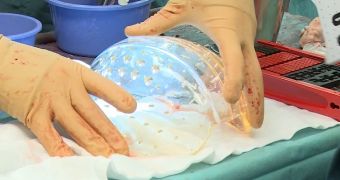The head is considered one of, if not the, most risky body part to conduct surgeries on, especially when it's the brain you need to work on. The intervention staged recently by Doctors from the University Medical Center (UMC) in Utrecht, Holland, was actually easy though.
Granted, they weren't conducting a brain surgery, but they did do something just as radically: they changed an entire skull.
And it was all possible thanks to 3D printing technology, which not only made it possible but made it easy to do everything.
Surgeons often remove and replace parts of the skull in order to cure concussions or other problems that cause brain swelling,
Now, though, they were able to replace a whole skull, which would not normally have been possible. After all, skulls don't grow on trees, and even if someone did donate their skull (for whatever reason) after death, it would not necessarily match the shape of the patient's brain.
3D printing solved all those problems. Based on a number of scans, a 3D model was created, then used to produce a replacement skull made of biocompatible plastic.
The procedure turned out to be very easy compared to the usual fare, because they only needed to “simply” replace the whole skull.
And since the skull had been made to fit the patient's anatomy perfectly, there was no need for any “cement” based skull implants or any of the traditional subtractive and modelling methods.
The patient was suffering from some added skull growth, which was putting pressure on her brain, impairing her ability to form facial expressions, as well as her eyesight. Pain was also an ever present symptom.
The intervention actually happened months ago, but none of the doctors or officials from the University Medical Center (UMC) in Utrecht, Holland, said anything. They wanted to make sure the 22-year-old patient was fully recovered first, and she is. No wonder such a big part of the whole world is in an uproar right now.
A CT scan was used as the 3D model by Anatomics, an Australian company that printed the replacement skull. It only had to be modified to remove the added skull growth.
“Now, these parts can be precisely created using highly precise, customized 3D printing technologies. This not only offers enormous benefits from a purely cosmetic point of view, but patients often have a better brain function seen compared to the old method,” said Doctor Bon Verwij, who led the team at UMC Utrecht.

 14 DAY TRIAL //
14 DAY TRIAL //